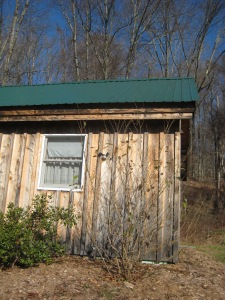 A little cabin in the woods. Very, very Thoreau. A nice place to hide out and write. Last week I revelled in a writers’ retreat at the Highlights Foundation in Boyds Mills, PA.
A little cabin in the woods. Very, very Thoreau. A nice place to hide out and write. Last week I revelled in a writers’ retreat at the Highlights Foundation in Boyds Mills, PA.
Anyway, outside my cabin was a gorgeous bush in full bloom. Covered with flowers.
What, you don’t see it? Right here.
A witch hazel bush. A native species–the best kind for landscaping. In full bloom.
Now if witch hazel bloomed in May, it would be totally overlooked by every person walking past, and more to the point, overlooked by any and all pollinators. But the fact that it blooms so ridiculously late in the year is what makes it a plant to remember.
Well, okay, maybe it doesn’t exactly hit you in the eye. The flowers are small. But the plant isn’t adapted to attract humans. It needs to attract pollinators.
Right. A bit too late for that, eh? The honeybees, the hummingbirds, the butterflies, all long gone. But witch hazel is pollinated by moths. There are several species of night-flying moths that depend on its nectar as a crucial food source–there isn’t that much nectar out there in the bitter end of autumn.
But how do moths manage to fly around sipping nectar, on November nights with the temperature well below freezing? They shiver.
I actually saw a moth do this once. The little insect shook and vibrated till I was afraid it would fall apart. This shivering serves the same purpose it does in a human, generating warmth by involuntary motion. The moth has to warm its muscles up to about 50 degrees before it can flutter off to look for food. On cold nights (is there any other kind in November?) the moth has to stop frequently to shiver its way back into flight.
I have to say I can’t help but feel sorry for all those poor shivering moths with nothing to eat but skinny little witch hazel flowers. But I suppose my pity is wasted, There’s an up side to being a pollinator in November. True, there’s not much to eat. But also there’s not as much around to eat you. Many of the insect-eating birds have headed south, bats are hibernating. 
And witch hazel has abundant nectar–hard to believe, looking at those skinny little petals. But I suppose in November you don’t have to be very big or bright to get noticed.





Normally I don’t read post on blogs, but I would like to say that this write-up very forced me to check out and do it! Your writing taste has been surprised me. Thank you, quite nice post.
Thank you so much for stopping by, I appreciate it!